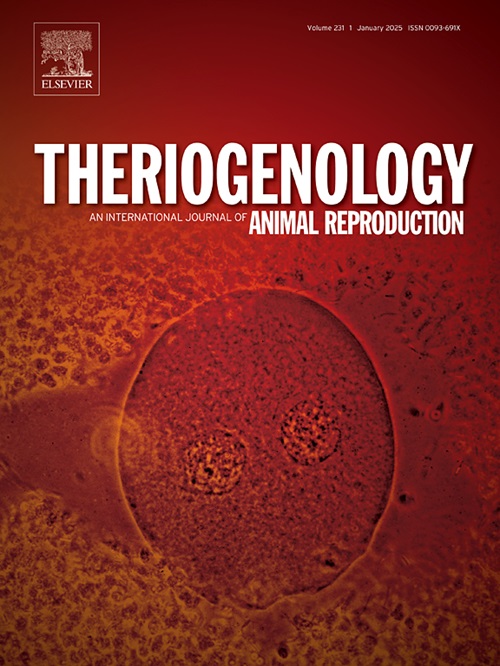对猫舍繁殖管理和避孕的见解——我们从一项在线调查中学到的
IF 2.4
2区 农林科学
Q3 REPRODUCTIVE BIOLOGY
引用次数: 0
摘要
出版的关于猫饲养者关于饲养管理和避孕的习惯的知识是有限的,但对有效的兽医支持猫饲养场至关重要。通过在线问卷调查,我们调查了繁殖者的来源、品种、繁殖母猫/雄猫的数量、第一次发情的年龄、避孕药和促排卵药物的使用情况或孕激素丸的治疗情况;proligestone注射;促性;注射用GnRH激动剂或植入地洛瑞林(dsli);褪黑素;阴道刺激,以及在雄猫中使用避孕药[黄体酮丸;proligestone注射;DSRI;褪黑激素)。参与研究的404名育种者来自24个国家的46个猫品种(德国(201,49.8%)和孟加拉猫(73,15.8%),其中大多数具有≥10年的经验(n = 195, 48.3%)。平均每个猫舍饲养3-4只完整的成年蚁后(n = 185, 45.8%)和1只完整的雄猫(n = 149, 36.9%)。育种者回答说,50.6% (n = 896)的女王在第一次发情时7-10个月大,长毛品种明显比短毛品种老(p <;0.0001)。皇后区最常服用黄体酮(n = 235, 47.4%),其次是dssri (n = 53, 10.7%)。在雄猫中,绝大多数育种者(n = 229, 53.3%)没有使用避孕措施,其次是dssi (n = 141, 32.8%)。在研究人群中,避孕药具在(北欧)欧洲最流行,而在北美最不常见。尽管有其局限性,这项大型的世界性研究为猫舍的生殖和避孕管理提供了相关的见解。一些与会者评论说,避孕药具的获取有限以及对当地兽医支持的不满,建议建立电话咨询服务和由专业兽医举办的育种者研讨会。本文章由计算机程序翻译,如有差异,请以英文原文为准。
Insights into breeding management and contraception in catteries – What we learned from an online survey
Published knowledge about cat breeders' habits regarding breeding management and contraception is limited, but vital for efficient veterinary support of catteries. With an online questionnaire, we surveyed breeders’ origin, breed, number of breeding queens/tomcats in the cattery, age at first estrus, use of contraceptives and ovulation-inducing drugs or treatment in queens [progestin pills; proligestone injection; hCG; GnRH agonists as injection or deslorelin implants (DSRI); melatonin; vaginal stimulation], as well as the use of contraceptives in tomcats [progestins pills; proligestone injection; DSRI; melatonin]. The participating 404 breeders of 46 cat breeds originated from 24 countries (German (201, 49.8 %) and Bengal breeders (73, 15.8 %) overrepresented) with the majority having ≥10 years of experience (n = 195, 48.3 %). In average, 3–4 intact adult queens (n = 185, 45.8 %) and one intact tomcat (n = 149, 36.9 %) were kept per cattery. Breeders answered that 50.6 % (n = 896) of their queens were 7–10 months old at first heat, long-haired breeds significantly older than short-haired (p < 0.0001). Progestin pills (n = 235, 47.4 %) were most commonly administered in queens, followed by DSRI (n = 53, 10.7 %). Regarding tomcats, the slight majority of breeders (n = 229, 53.3 %) did not use contraceptives, next common were DSRI (n = 141, 32.8 %). Within the study population, contraceptives were most popular in (Northern) Europe, while least common in Northern America. Despite its limitations, this large worldwide study provides relevant insights into reproductive and contraceptive management of catteries. Limited access to contraceptives and dissatisfaction with local veterinary support as commented by several participants suggest the establishment of telephone consultation services and breeder seminars by specialized veterinarians.
求助全文
通过发布文献求助,成功后即可免费获取论文全文。
去求助
来源期刊

Theriogenology
农林科学-生殖生物学
CiteScore
5.50
自引率
14.30%
发文量
387
审稿时长
72 days
期刊介绍:
Theriogenology provides an international forum for researchers, clinicians, and industry professionals in animal reproductive biology. This acclaimed journal publishes articles on a wide range of topics in reproductive and developmental biology, of domestic mammal, avian, and aquatic species as well as wild species which are the object of veterinary care in research or conservation programs.
 求助内容:
求助内容: 应助结果提醒方式:
应助结果提醒方式:


